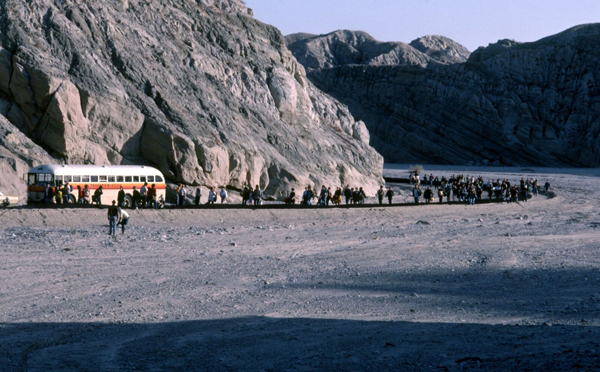Your cart is currently empty!
BUNKER VISION

Commerce imitates art. If you recently spent a small fortune to attend a cultural event in a desert locale, it probably contains DNA from a series of conceptual concerts that were staged in the Los Angeles area between 1983 and 1985. The organizer of these events was Stuart Swezey, who is best known for his Amok Press publishing venture. At the time of these shows, punk rock had not been sufficiently monetized to be nonthreatening. The LAPD would actually look through music listings and show up in riot gear when certain bands had shows at legitimate venues. This led to a cat-and-mouse game where shows were staged in secret at warehouses and suburban backyards—and even these shows got raided. Swezey decided to approach staging a concert as conceptual art and launched the first Desolation Center show in 1983 at an undisclosed desert location. To keep the show completely secret he transported the audience to the show in rented school buses.

Considering how much time people spend preparing for Coachella and Burning Man, it is rather wonderful to imagine a more innocent time when people jumped onto a school bus in leather jackets and Doc Martens with no thought of sunscreen or even bottled water. A woman who appears in a new documentary about these shows (Desolation Center) stops mid-sentence as she reminisces to ask: “You didn’t have permits for these, did you?” As the film explains, not only did they not have permits, they were improvising as they went along. The first show (featuring the Minutemen and Savage Republic) was successful enough for them to double the number of school buses from three to six for a second show that featured Mark Pauline’s Survival Research Laboratory robot spectacles and Einsturzende Neubauten, a German band who used chainsaws and electric tools to create its unique sound. In order to keep the concept fresh, the third Desolation Center show was staged in the San Pedro harbor surrounded by industrial cranes and docks on a repurposed whale-watching boat.

When the last two shows moved back to the desert, a decision was taken to allow people to drive their own cars to the event. This created a new phenomenon (used by most of the raves later that decade) of using checkpoints where people obtained maps to the next checkpoint to keep the location secret. The fourth show featured the West Coast debut of Sonic Youth, and Psi Com, a band that included Perry Farrell (who gave a shout-out to Desolation Center when he announced his Lollapalooza project). The documentary follows the line of history from there to Burning Man and Coachella. Swezey recently mounted a museum-worthy show of artifacts from these ventures at Cornelius Projects in San Pedro. Hopefully the appearance of the documentary will prompt an adventurous curator to get this show onto the touring museum show circuit. Both the film and the art show are a window into an era where social media wasn’t there to set the agenda or spoil the fun. Art for art’s sake!